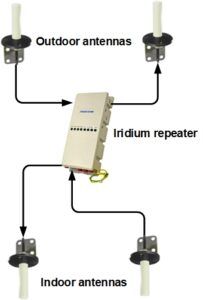How do we use Iridium satphones indoors?
Iridium satellite phones are most commonly used in environments where traditional communication networks are unavailable or unreliable.
By traditional, I mean remote locations where there is no access to a landline or cellular signal.
Actually, cellular signals propagate quite well across the surface of an ocean and can easily be received up to 2-3 miles offshore under normal conditions.
With favourable weather conditions and no obstructions, signals might reach up to 10 miles offshore.
However, when operating outside the reach of traditional phone networks, satphones are essential while bobbing about on the ocean wave, in the frozen Arctic or Antarctic regions, or in any remote wilderness that you may find yourself in.
Iridium Communications Inc. operates the Iridium satellite constellation of 66 active satellites (with some spares) in low Earth orbit (LEO) approximately 780 km / 485 miles above the surface of the Earth. The constellation is arranged in six polar orbits, each containing 11 satellites.
This configuration allows Iridium to provide reliable, global communication coverage, including the polar regions.
What happens when Iridium signal is required inside a building?

Here’s an example: an organization based in a UK university uses smart buoys to monitor wind speed, air temperature, and wave height at strategic locations at sea. Instrumentation on the buoys relays data back to the base at the university via short-burst data (SBD) messages. The data is collated and used to form an overall picture of conditions at sea.
It’s neat (vital) technology that provides real time data about sea conditions, but the HQ office is on the ground floor of a three-storey building and has no Iridium reception at all.
An Iridium repeater system was installed to relay the outdoor signal inside the building.
In fact, it also relays signal from inside the building up to the satellites overhead, since Iridium provides full duplex voice and data communications.
Iridium repeater options
There are systems with fibre optic interfaces that can stretch the distance from outdoor antennas to indoor space by up to 3Km if required.
The optical fibre solution would suit a situation like an emergency control bunker that is buried in the basement of a building.
Coaxial systems do the same job over shorter distances, where optical fibre isn’t needed to cover large distances.
Optical and coaxial Iridium repeater kits are supplied with all parts needed for installation, including antennas, cables and repeater units.
